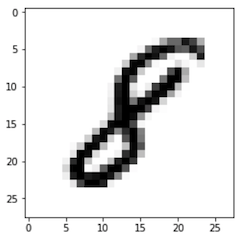Notations
Before we dive right into the various algorithms of deep learning, we should get acquainted with the common notations used.
Consider this image of a digit
 |
| Image source : MNIST |
This training example contains a 28x28 pixel image along with its correct label, i.e, 8.
Within the computer, this image is stored as a matrix of pixel intensities
Each pixel contains within it, a number from 0-255 representing the intensity of black (with 0 being total absence of black, i.e., white, and 255 being totally black)
Therefore, in the eyes of a computer, this image would be something like this
If we try to turn these pixel intensity values into a feature vector, what we do is unroll all these pixel intensity values into an input feature vector x.
So we'll take all the pixel values starting from 0, 0, 0....1, 12, 0, 11, 39... until we get a very long feature vector (of size (64x64 =)4096) listing out all the pixel intensities
$$X = \begin{bmatrix} 0 \\ 0 \\ . \\ . \\ . \\ 1 \\ 12 \\ 0 \\ 11 \\ . \\ . \\ 0 \\ 0\end{bmatrix}$$
Therefore, we're going to write nx = 4096 to represent the dimension of the input feature vector x.
Sometimes for simplification, we might also just use n
So for a classification algorithm, our goal is to an image represented by a feature vector x, and predict the corresponding label y (that lies between 0-9) accurately
A single training example is represented by a pair, i.e., (x,y) where x is an nx dimensional feature vector and y lies from 0-9
Your training set comprises of m training examples
So your training set will be written as {(x(1), y(1)), (x(2), y(2))....(x(m),y(m))}
...where (x(1), y(1)) are the input and output of your 1st training example and (x(2), y(2)) are the input and output of your 2nd training example and so on till the last training example (x(m),y(m)) where (x(m),y(m)) are the input and output of your mth training example
and all these all together form your training set.
Sometimes, to emphasize that m is the number of training examples we write it as mtrain
Similarly, we represent the number of test set with mtest
Finally, to put all of the training examples into a more compact notation, we're going to define a matrix X, as defined by taking all your training examples (x(1), x(2)..and so on) and stacking it column-wise, like so.
$$X = \begin{bmatrix}. & . & & & & & . \\. & . & & & & & . \\ . & . & & & & & . \\x^{(1)} & x^{(2)} & . & . & . & . & x^{(m)}\\ . & . & & & & & . \\ . & . & & & & & . \\ . & . & & & & & . \end{bmatrix} $$
having m columns where m is the number of training examples
and each training example has nx rows
Therefore, X is a nxxm dimentional matrix.
X.shape = (nx, m)
Similarly, we also stack the output y as columns, like
$$Y = \begin{bmatrix}y^{(1)} & y^{(2)} & . & . & . & . & . &y^{(m)}\end{bmatrix}$$
making it a 1xm dimensional matrix
Y.shape = (1, m).
Previous Post : Plotly
Next Post : Logistic Regression




Comments
Post a Comment